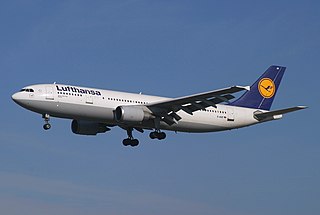
The Airbus A300 is Airbus's first production aircraft and the world's first twin-engine, double-aisle (wide-body) airliner, developed and manufactured by Airbus from 1971 to 2007.

American Airlines Flight 587 was a regularly scheduled international passenger flight from John F. Kennedy International Airport to Las Américas International Airport in Santo Domingo, the capital of the Dominican Republic. On November 12, 2001, the Airbus A300B4-605R flying the route crashed into the neighborhood of Belle Harbor on the Rockaway Peninsula of Queens, New York City, shortly after takeoff. All 260 people aboard the plane were killed, as well as five people on the ground. It is the second-deadliest aviation accident in U.S. history, behind the crash of American Airlines Flight 191 in 1979, and the second-deadliest aviation incident involving an Airbus A300, after Iran Air Flight 655.

An aviation accident is defined by the Convention on International Civil Aviation Annex 13 as an occurrence associated with the operation of an aircraft, which takes place from the time any person boards the aircraft with the intention of flight until all such persons have disembarked, and in which (a) a person is fatally or seriously injured, (b) the aircraft sustains significant damage or structural failure, or (c) the aircraft goes missing or becomes completely inaccessible. Annex 13 defines an aviation incident as an occurrence, other than an accident, associated with the operation of an aircraft that affects or could affect the safety of operation.

Nagoya Airfield, also known as Komaki Airport or Nagoya Airport, is an airport which lies within the local government areas of Toyoyama, Komaki, Kasugai and Nagoya in Aichi Prefecture, Japan. Prior to 2005, it was once an international airport, but is now a domestic secondary airport serving Nagoya while the current primary civil airport for Nagoya is Chūbu Centrair International Airport in Tokoname.
This is a list of aviation-related events from 1994.

China Northern Airlines was an airline headquartered on the grounds of Shenyang Taoxian International Airport, Shenyang, Liaoning, People's Republic of China. Established on June 16, 1990, it was one of the six backbone airlines directly under the Civil Aviation Administration of China.
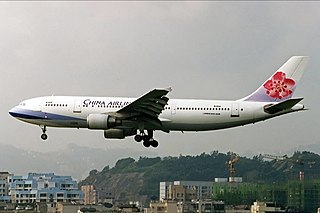
China Airlines Flight 676 was a scheduled international passenger flight. On Monday, 16 February 1998, the Airbus A300 jet airliner operating the flight crashed into a road and residential area in Tayuan, Taoyuan County, near Chiang Kai-shek International Airport, Taiwan.

Aeroflot Flight 593 was a passenger flight from Sheremetyevo International Airport, Moscow, Russia, to Kai Tak Airport in Hong Kong. On 23 March 1994, the aircraft operating the route, an Airbus A310-304 flown by Aeroflot, crashed into the Kuznetsk Alatau mountain range in Kemerovo Oblast, killing all 63 passengers and 12 crew members on board.

Pakistan International Airlines Flight 268 was an Airbus A300, registration AP-BCP, which crashed while approaching Kathmandu's Tribhuvan International Airport on 28 September 1992. All 167 people on board were killed. Flight 268 is the worst crash of Pakistan International Airlines, and the worst ever to occur in Nepal.
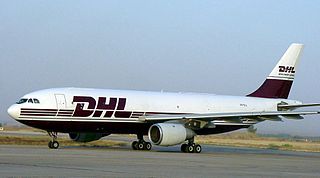
On 22 November 2003, shortly after takeoff from Baghdad, Iraq, an Airbus A300B2-200F cargo plane, registered OO-DLL and owned by the Belgian division of European Air Transport, was struck on the left wing by a surface-to-air missile while on a scheduled flight to Muharraq, Bahrain. Severe wing damage resulted in a fire and complete loss of hydraulic flight control systems. Because outboard left wing fuel tank 1A was full at takeoff, no fuel-air vapour explosion occurred. Liquid jet fuel dropped away as 1A disintegrated. Inboard fuel tank 1 was pierced and leaking.

Garuda Indonesia Flight 152 (GA152/GIA152) was a scheduled domestic flight operated by Garuda Indonesia from Soekarno-Hatta International Airport, Tangerang, to Polonia International Airport, Medan, in Indonesia. On 26 September 1997, the aircraft flying the route crashed into mountainous woodlands near the village of Buah Nabar, Sibolangit, killing all 222 passengers and 12 crew members on board. It is the deadliest aviation disaster in Indonesia's history.

Thai Airways International Flight 261 (TG261/THA261) was a scheduled domestic passenger flight from Bangkok's Don Mueang International Airport to Surat Thani International Airport in Surat Thani, Thailand. The flight was operated by Thai Airways International, the flag carrier of Thailand. On 11 December 1998, the aircraft, an Airbus A310-204 registered in Thailand as HS-TIA, stalled and crashed into a swamp during its landing attempt at Surat Thani Airport. A total of 101 people were killed in the crash.
Ha'il Regional Airport is an airport serving Ha'il, the capital of the Ha'il Province in Saudi Arabia.

AeroUnion Flight 302, operated by an Airbus A300B4-203F cargo aircraft, crashed in poor weather on final approach at General Mariano Escobedo International Airport, Monterrey, Mexico around 23:18 CDT on 13 April 2010, after a flight from Mexico City. All five people on board were killed, as well as one on the ground.
In aeronautics, loss of control (LOC) is the unintended departure of an aircraft from controlled flight and is a significant factor in several aviation accidents worldwide. In 2015 it was the leading cause of general aviation accidents. Loss of control may be the result of mechanical failure, external disturbances, aircraft upset conditions, or inappropriate crew actions or responses.
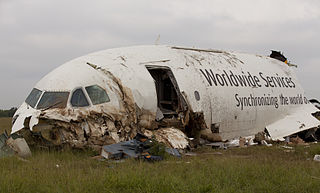
UPS Airlines Flight 1354 (5X1354/UPS1354) was a scheduled cargo flight from Louisville, Kentucky, to Birmingham, Alabama. On August 14, 2013, the Airbus A300 flying the route crashed and burst into flames short of the runway on approach to Birmingham–Shuttlesworth International Airport. Both pilots were pronounced dead at the scene of the crash. They were the only people aboard the aircraft. It was the second fatal air crash for UPS Airlines.

Malaysian Airline System Flight 684 (MH684/MAS684) was a scheduled international passenger flight of Malaysian Airline System from Singapore Changi Airport in Singapore to Subang International Airport, in Subang, Malaysia. On 18 December 1983, the Airbus A300B4-120 operating the flight crashed 2 km short of the runway while landing at Subang International Airport. There were no fatalities among the 247 passengers and crew.

Civil Air Transport Flight 10 was a passenger flight from the now-closed Kai Tak Airport in Hong Kong to Songshan Airport in Taipei, Taiwan. The flight was operated by a Boeing 727-92C with registration B-1018 and named "Super Cuihua." On 16 February 1968, the aircraft crashed into a Hunan village in Linkou Township, Taipei County, killing 21 of the 63 people on board as well as one person on the ground. 42 people were injured.
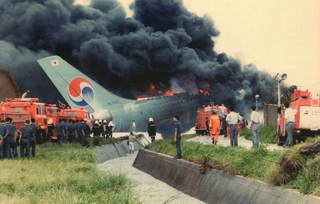
Korean Air Flight 2033 was a scheduled passenger flight from Seoul to Jeju, South Korea. On 10 August 1994, the Airbus A300 serving the route overran the runway on landing at Jeju International Airport in poor weather and burst into flames. All 160 people on board escaped without serious injury, but the aircraft was destroyed.




















